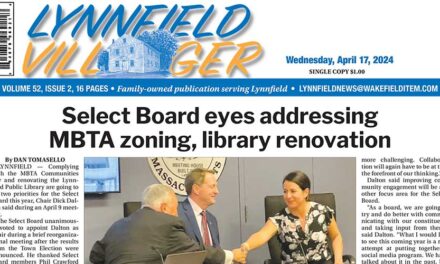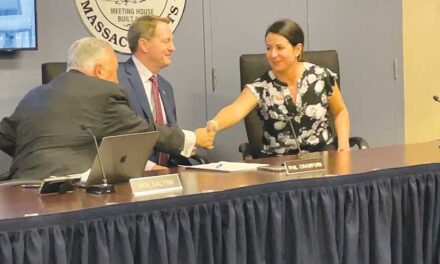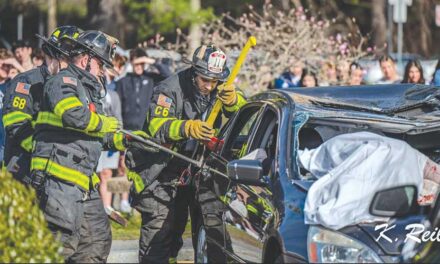Published in the September 2, 2015 edition
By DAN TOMASELLO
LYNNFIELD — The Planning Board voted unanimously Aug. 26 to recommend four zoning articles for the October Town Meeting, including an amendment to the zoning bylaw that would prohibit movable signs.
The proposed warrant article states “signs shall neither contain moving elements nor convey the appearance of movement, whether by changing pixilation or any other physical or electronic representation of movement.” The proposed amendment was scheduled to appear on the April Town Meeting warrant but that plan was nixed because the second session of April Town Meeting did not have a quorum.
The Planning Board will be sending the four warrant articles to the Board of Selectmen, who will place the articles on the Oct. Town Meeting warrant. The fall session of Town Meeting will be held on Monday, Oct. 19.
Planning Board Co-Chairman John Faria said the Planning Board endorsed the movable signs amendment because it’s designed to prohibit any potential digital billboards from being erected in town.
“We are well aware of the difficulties of flashing billboards and this is an attempt to curtail that in the future,” said Faria. “We don’t want flashing lights on Route 1 North and on Salem Street. We would like to have something in place to keep the status quo so we don’t have flashing lights going into people’s bedrooms.”
Faria said the bylaw would be enhanced and developed over time if it gets approved.
Public reaction
There were nine attendees at the Planning Board’s public hearing on the proposed four warrant articles, including Selectman Tom Terranova. Eight residents expressed their support for the bylaw amendment, while one resident opposes it.
David Kulakowski, 17 Munroe St., asked the planners if movement also includes moving signs such as the digital billboard in Peabody. He said the billboard is a mile from his home.
“I can see it right from my backyard,” said Kulakowski.
Faria doesn’t believe there is anything Lynnfield could do about the digital billboard in Peabody because it’s not a “public nuisance” in addition to it being located in a neighboring city. He said neighbors could fight the billboard if they argue it’s a “private nuisance” at the state level.
“I do believe there is a chance it could be stopped but it has be done on a private level, not a pubic level,” said Faria.
Heather Keane, 23 Canterbury Rd., inquired what zoning districts in town do not prohibit signs with flashing lights.
Planning Board Co-Chairman Alan Dresios said the only two districts that do not prohibit signs with flashing lights are Route 1 North and the area near Kimball Lane.
Wally McKenzie, 4 Debston Lane, asked the Planning Board if the zoning amendment would stop the rotating signs located at MarketStreet Lynnfield.
Faria said the planners voted 4-1 to send a cease and desist letter to MarketStreet requesting the movable signs to stop but he said the Planning Board has not “taken any action further on that particular subject.”
McKenzie also inquired if the signage bylaw amendment would apply to facades such as the facade located at Kings.
Faria said the bylaw would not apply to facades. However, he said if residents want the signage amendment to apply to facades, residents would need to go to Town Meeting and “seek a minor amendment.” He also noted MarketStreet voiced its opposition to the sign bylaw amendment last spring because National Development believed the amendment applied to the outdoor mall.
“This (amendment) does not apply to MarketStreet,” said Faria. “They have a whole set of rules that apply to them.”
Dresios also said MarketStreet is a 40R district, which he said is a “state district.”
Janice Nearen-Bell, 24 Canterbury Rd., presented a white paper by Jonathan Snyder and Samuel S. Fels Fund called “Beyond Aesthetics: How Billboards Affect Economic Prosperity.” Nearen-Bell said the white paper argues billboards reduce townspeople’s property values if they are erected in cities and towns.
“Using 2010 sale price data and taking into account adjacent amenities such as libraries and parks, residential real estate within 500 feet of a billboard is $30,826 less than valuable at the time of the purchase,” said Nearen-Bell while reading the white paper.
Faria said the Planning Board is “highly sensitive” to the needs of South Lynnfield.
“We see that is a high impact area and we are watching what is happening up there carefully,” said Faria.
Patrice Lane resident Pat Campbell expressed her support for the bylaw amendment because she said digital billboards would “diminish the character of Lynnfield” if they get erected in town.
Terranova reiterated his support of the bylaw amendment because he believes digital billboards could be a “safety hazard.”
Resident rips proposal
While the majority of residents who attended the meeting expressed their support for the sign bylaw amendment, Salem Street resident Mark Donovan said he opposes it.
“I think this (bylaw) is very limiting to (business owners) on Route 1 North,” said Donovan. “I think it’s discriminatory. I totally object to it. If things are done tastefully, they can be can be done right and can appease everybody.”
Faria said the term tastefully could be interpreted differently. He asked Donovan how the bylaw could be changed while still protecting the town’s “aesthetics.”
Donovan said other communities in the state allow businesses to use movable electronic signs and questioned why Lynnfield is going in the opposite direction. He said the amendment “shuts the door” on what local businesses can do with their property.
“It’s like bullying,” said Donovan. “It’s like having 30 people against one.”
Nearen-Bell, Kulakowski and Keane said they are not against having signs on Route 1, but said they want to protect the character of their neighborhoods.
“We are not trying to take away the signs,” said Kulakowski. “We are trying to take away the offensive signs. No one is going to prevent you from putting a sign up that meets the restrictions, we just don’t want all of the flashy stuff to leak into our homes and backyards.”
Keane agreed.
“I have lived on Canterbury Road for almost 18 years and we have had a lot of changes,” said Keane. “We have tried to work with a lot businesses for a long time. We are not difficult people; we just want to make our homes and where we live look nice. We don’t want any ugly signs. It’s as simple as that.”




